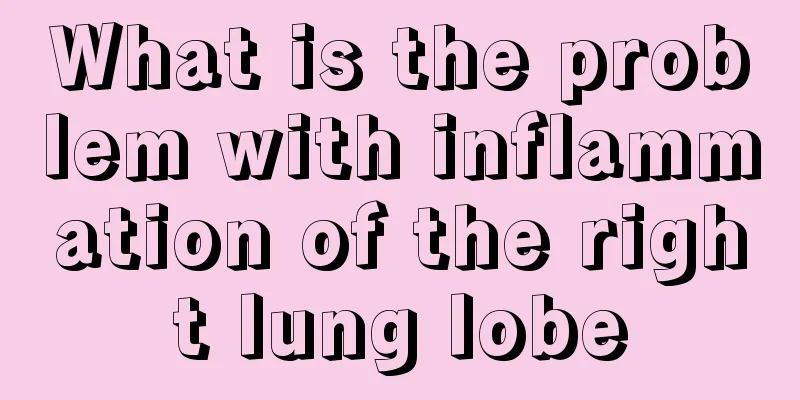Characteristics of rheumatic pericarditis Rheumatic pericarditis is like this

|
Rheumatic pericarditis is a type of pericarditis, which can cause great damage to the visceral layer of the pericardium. Therefore, it is particularly important to understand the characteristics of rheumatic pericarditis and prevent it. In fact, the most important characteristic of rheumatic pericarditis is that its onset is mainly related to rheumatism. However, not every patient with rheumatic disease will suffer from this disease. Only 15% of patients with rheumatic disease will suffer from rheumatic pericarditis. The pericardium is almost always involved in rheumatic disease, but clinically, only 15% of cases of rheumatic pericarditis are diagnosed. The lesions mainly involve the visceral pericardium, presenting as serous or serous fibrinous inflammation, and fibrinoid degeneration may occur in the epicardial connective tissue. There may be a large amount of serous exudate (pericardial effusion) in the pericardial cavity. On percussion, the heart borders are enlarged to the left and right, heart sounds are distant on auscultation, and on X-ray examination, the heart is pear-shaped. When a large amount of fibrin exudates, the cellulose on the surface of the epicardium becomes villus-like due to the continuous beating of the heart, which is called villous heart (corvillosum). During the recovery period, the serous fluid is gradually absorbed, and most of the cellulose is also dissolved and absorbed, with a small part of it becoming organized, causing partial adhesion of the visceral and parietal layers of the pericardium. In very rare cases, the pericardium can heal completely, forming constrictive pericarditis. Inflammation of the heart's envelope is called pericarditis. This disease can exist alone or coexist with myocarditis and endocarditis. It is generally divided into acute pericarditis and constrictive pericarditis. 1. Acute pericarditis 1.Pericarditis is an inflammation of the heart's envelope. Acute pericarditis is a type of pericarditis. Acute pericarditis can have a variety of causes. According to the cause, it can be divided into (1) Tuberculous pericarditis: It is caused by infection with Mycobacterium tuberculosis and is more common in children and adolescents. It is often spread and disseminated from pulmonary tuberculosis or mediastinal tuberculosis. (2) Nonspecific pericarditis: may be caused by viral infection, often occurs 2 to 3 weeks after upper respiratory tract infection, and is more common in young people; (3) Rheumatic pericarditis: It is a part of rheumatic pancarditis and is more common in adolescents; (4) Purulent pericarditis: caused by Staphylococcus aureus or other pathogens, often secondary to sepsis or septicemia, or spread from purulent inflammation of adjacent tissues; (5) Uremic pericarditis: caused by uremic stimulation, more common in the late stage of uremia; (6) Others: pericarditis after heart damage, cardiac amyloidosis, hypothyroidism, etc. 2. The main manifestations of acute pericarditis are (1) Systemic symptoms: There are large differences. Pericarditis caused by infection usually presents with fever. (2) Chest pain: It can be stabbing or dull, with great variation. It can worsen with breathing, coughing, swallowing, or changes in body position. It is usually located in the precordial area or sternum. Tuberculous pericarditis may not cause chest pain. (3) Symptoms of cardiac compression: such as upper abdominal distension and pain, vomiting, lower limb edema, cyanosis, shortness of breath, etc. (4) Symptoms of compression of adjacent organs, such as difficulty breathing, difficulty swallowing, hoarseness, etc. At different stages of the disease, auscultation may reveal pericardial friction rubs, and echocardiography may reveal pericardial effusions. When the cause is unclear, pericardial biopsy should be done to confirm the diagnosis. Estimation of pericardial effusion volume: Small amount of pericardial effusion (500ML): The liquid dark area is largest on the inner and outer sides of the heart, and there is also an obvious dark area in the anterior pericardium. The principle of treatment is to actively treat the primary disease, improve symptoms, and relieve circulatory disorders. If necessary, treatment measures such as pericardiotomy and drainage, pericardiocentesis, and fluid extraction can be performed. 2. Constrictive pericarditis Constrictive pericarditis is a type of pericarditis. This disease is caused by the contraction of granulation tissue in the pericardial cavity in a small number of patients after acute pericarditis, forming a fibrous shell and partial or complete occlusion of the pericardial cavity. Most of them are caused by tuberculous pericarditis or purulent pericarditis. The main symptoms are manifestations of cardiac compression, often with palpitations, shortness of breath, fatigue, abdominal distension, loss of appetite, weight loss, edema, etc. Examination may reveal cyanosis, unclear apical beat, rapid heart rate, pericardial impact sound, distended jugular veins, hepatomegaly, ascites, lower limb edema, weak and compressed pulse, and pulsus paradoxus. Venous pressure increased significantly. X-ray, electrocardiogram, cardiac catheterization, echocardiography and other examinations are helpful for diagnosis. Surgery is usually used for treatment. |
<<: How are stones formed? This is what happens when stones are formed.
>>: How to remove the odor of new house decoration and move in faster
Recommend
What causes dry cough without phlegm? Three common triggers
Dry cough without sputum is a very common phenome...
Main varieties of wine grapes
Grape wine is also called fruit wine. After the f...
The efficacy and contraindications of Jinsha Stone
Jinsha stone is one of the few stones on the mark...
Why does bladder cancer recur?
Patients who have undergone bladder cancer surger...
The most common early symptoms of skin cancer
Skin cancer is one of the most common skin diseas...
A major killer of health, what exactly is atherosclerosis?
If we talk about diseases that afflict many middl...
10 Weird But Effective Health Tips
1. Green apples can relieve anxiety If you feel c...
Ointment for acne
Everyone who loves beauty has a few pimples on th...
What should lung cancer patients pay attention to in their diet after surgery? Two key points to pay attention to in their diet after lung cancer surgery
Lung cancer is a disease that generally requires ...
What are the effects of placenta cream
After a woman gives birth, she will have a placen...
I have small pimples on my neck. What should I pay attention to in my diet?
There are many factors that cause small pimples o...
Is there any harm in tooth extraction
Tooth extraction is a common method of treating d...
Gather together, the class on tips for removing frostbite scars is about to begin!
Due to the cold weather in winter, the face and h...
Sweating at night
With the continuous development of modern industr...
What kind of harm will fibroids have on the body
Nowadays, people often encounter fibroids in thei...









